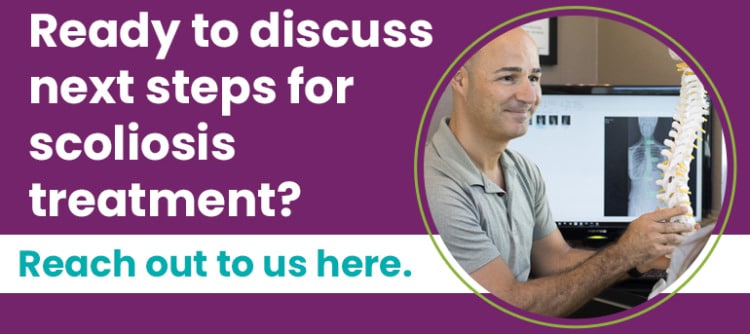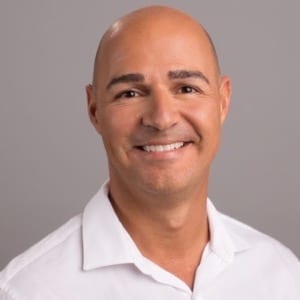What Is Sigmoid Scoliosis? Symptoms and Treatment
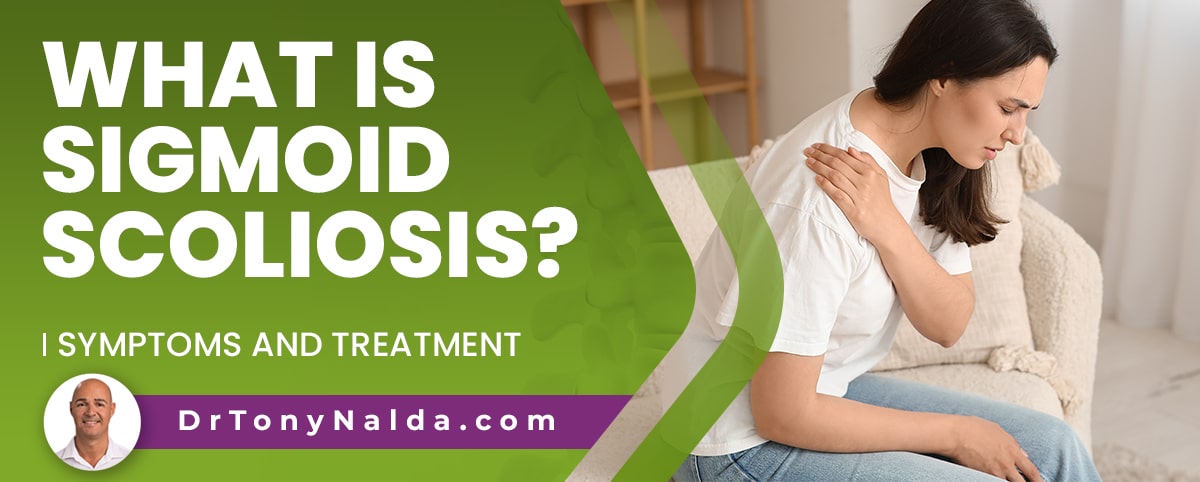
Part of treating scoliosis effectively involves comprehensive assessment so conditions can be further classified based on key variables that shape treatment plans. There are three main spinal sections, and scoliosis can develop in any section, or in more than one as a combined scoliosis.
There are different severity levels and types of scoliosis, and sigmoid scoliosis refers to when there are two unnatural spinal curves, also commonly referred to as an S-curve scoliosis and/or a double-curve scoliosis.
Scoliosis causes the spine to bend unnaturally to the side and rotate, and an unnatural spinal curve can have different characteristics and treatment needs.
Table of Contents
Spinal Curve Location
There are both healthy and unhealthy spinal curves. A healthy spine will have a characteristic curve type in each of its main sections: the cervical spine (neck), thoracic spine (middle/upper back), and the lumbar spine (lower back).
Healthy and natural spinal curves make the spine more flexible, stronger and more resistant to injury, and better able to absorb and distribute mechanical stress throughout the spine evenly.
The spine naturally bends inwards in the cervical and lumbar spinal sections, known as lordosis, while the thoracic spine features an outward curvature of the spine known as kyphosis.
Healthy Versus Unhealthy Spinal Curves
People can have different curve sizes and still have a healthy spine, but if a person's curve size falls beyond a normal range, problems can occur.
Scoliosis causes an unnatural lateral spinal curve to develop, so the spine will bend to the side, and the rotational component makes it twist from back to front, front to back, and scoliosis can develop in any of the spine's main sections.
So scoliosis that develops in the cervical spine is diagnosed as cervical scoliosis, and scoliosis that affects the thoracic spine is thoracic scoliosis, and scoliosis that develops in the lower back is lumbar scoliosis.
A common scoliosis location is thoracolumbar scoliosis; when a curve develops in the upper lumbar spine and the lower thoracic spine, this is an S-shaped scoliosis.
Scoliosis Symptoms and Curve Location
It's important that curve location is determined so treatment can be planned accordingly, and an X-ray allows us to see what's happening in and around the spine, as well as where treatment efforts need to be concentrated.
Curvature location also helps predict the types of symptoms patients are likely to experience. In most cases, the area of the body located the closest to the affected spinal section is going to be the most likely to feel the condition's direct effects.
For example, a common complication of lumbar scoliosis is sciatic nerve pain because the sciatic nerve starts in the lower back, so if an unnatural spinal curve is compressing the sciatic nerve, it can cause pain and discomfort felt anywhere along the nerve's extensive pathway.
When there is more than one unnatural spinal curve, this is known as sigmoid scoliosis.
Sigmoid Scoliosis
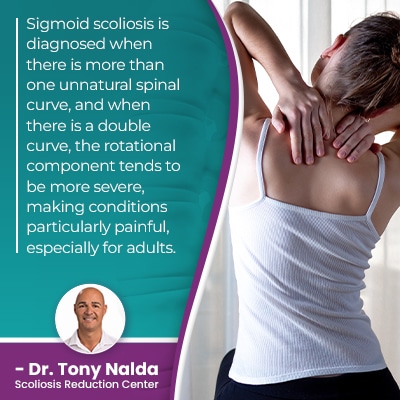 Sigmoid scoliosis is diagnosed when there is more than one unnatural spinal curve, and when there is a double curve, the rotational component tends to be more severe, making conditions particularly painful, especially for adults.
Sigmoid scoliosis is diagnosed when there is more than one unnatural spinal curve, and when there is a double curve, the rotational component tends to be more severe, making conditions particularly painful, especially for adults.
Adult scoliosis is commonly painful while childhood scoliosis is not; this is because scoliosis doesn't become a compressive condition until skeletal maturity has been reached.
When the spine is still growing, it's experiencing a constant lengthening motion that counteracts the compressive force of the unnatural spinal curve, and it's compression of the spine and its surroundings that causes the majority of condition-related pain.
When sigmoid scoliosis is first diagnosed, the curve location and type has to be comprehensively assessed. The major curve will be determined and be the focus of treatment.
Both the major and minor curve will be classified individually based on its location, direction, and severity.
In most typical cases of idiopathic scoliosis, curves bend to the right, away from the heart (dextroscoliosis), but in atypical cases, curves can bend to the left, towards the heart (levoscoliosis), and these cases are a red flag that there is an underlying pathology causing the scoliosis.
Treatment Options for Sigmoid Scoliosis
Treatment options for sigmoid scoliosis curves include surgery or conservative treatment that offers a non-surgical alternative.
While traditional scoliosis treatment funnels patients towards spinal fusion surgery, conservative treatment values a proactive response that's started immediately following a diagnosis with the goal of preventing progression, increasing condition severity, and the need for invasive surgical treatment.
Once both curves are assessed and classified, the major curve will be the focus of treatment.
Surgical Treatment
Spinal fusion surgery responds by fusing the curve's most-tilted vertebrae into one solid bone and attaching metal rods to the spine to hold it in place; this would be done at two locations to straighten both unnatural spinal curves.
While each patient will respond to spinal fusion in their own way, spinal surgery is always risky and comes with some serious potential side effects and complications.
Spinal fusion can make the spine more rigid, less flexible, and more painful at the fusion site, and in addition, a fused spine is weaker and more vulnerable to injury.
There are also risks associated with the procedure itself from infection to nerve damage and excessive blood loss, but there are also long-term risks patients need to be aware of, and once a spine is fused, it's fused for life.
If spinal fusion is unsuccessful for any reason, the only recourse is more surgery, and the risks of spinal fusion increase with age and with each subsequent surgical procedure.
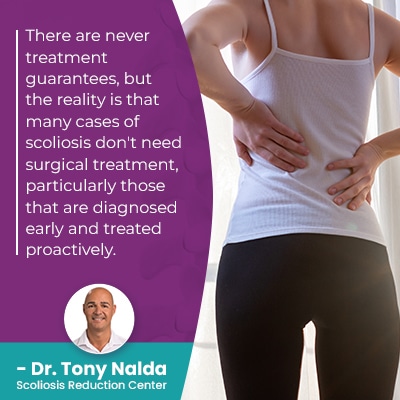 There are never treatment guarantees, but the reality is that many cases of scoliosis don't need surgical treatment, particularly those that are diagnosed early and treated proactively.
There are never treatment guarantees, but the reality is that many cases of scoliosis don't need surgical treatment, particularly those that are diagnosed early and treated proactively.
Non-Surgical Treatment
Non-surgical scoliosis treatment is proactive; it's started immediately following a diagnosis with the goal of preventing progression.
Sigmoid scoliosis is more complex to treat because there is more rotation, and there are two unnatural spinal curves to address, but scoliosis correction achieved through conservative treatment options is better for long-term spinal health and function.
Conservative treatment involves condition-specific chiropractic care that works towards adjusting the curve's most-tilted vertebrae back into a healthy alignment with the rest of the spine; once the major curve is adjusted, the minor curve can be addressed.
A healthy spine needs to be supported, and this is where physical therapy and scoliosis exercises come into play; the back and core muscle strength and balance can be improved for optimal spinal support and stability.
Non-surgical treatment focuses on how to preserve as much of the spine's natural strength and function as possible.
Corrective bracing can also help by pushing the spine into a corrective position, and as growing spines are more malleable, bracing is a common facet of childhood scoliosis treatment.
Rehabilitation is the ongoing portion of treatment; as a progressive condition, treatment is about managing a life-long condition, but it can be highly treatable.
Conclusion
There are many different severity levels of scoliosis from mild scoliosis to moderate, severe and very severe, and there are also different types of scoliosis from idiopathic scoliosis to neuromuscular scoliosis, degenerative scoliosis, and congenital scoliosis.
Risk factors for scoliosis include age, gender, and a family history, and scoliosis is diagnosed through a physical examination, an adam's forward bend test, and the results of a scoliosis X-ray.
There are also different curvature locations, types, and patterns to be assessed.
Most cases of scoliosis involve a single unnatural sideways curvature of the spine with rotation, and in cases of sigmoid scoliosis, there are two unnatural spinal curves.
When sigmoid scoliosis is being diagnosed, each curve has to be assessed and classified based on location, severity, and type.
When the major curve and minor curve are determined, the major curve is the focus of treatment, and once a curvature reduction of the main curve is worked towards, the same can be applied to the minor curve, and reducing these curves on a structural level is the primary focus.
What's most important to understand about sigmoid scoliosis is that there are two ways to respond with treatment: surgery or a non-surgical conservative treatment approach.
It's also important to understand that as a progressive condition, the nature of scoliosis is to get worse over time, hence the benefit of diagnosing and treating scoliosis proactively.
Here at the Scoliosis Reduction Center®, conditions are treated proactively and impacted on every level. Through an integrative and innovative approach, sigmoid scoliosis correction can be worked towards.
Dr. Tony Nalda
DOCTOR OF CHIROPRACTIC
After receiving an undergraduate degree in psychology and his Doctorate of Chiropractic from Life University, Dr. Nalda settled in Celebration, Florida and proceeded to build one of Central Florida’s most successful chiropractic clinics.
His experience with patients suffering from scoliosis, and the confusion and frustration they faced, led him to seek a specialty in scoliosis care. In 2006 he completed his Intensive Care Certification from CLEAR Institute, a leading scoliosis educational and certification center.
About Dr. Tony Nalda
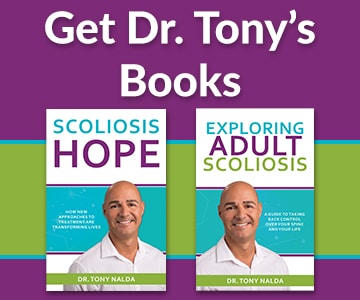 Ready to explore scoliosis treatment? Contact Us Now
Ready to explore scoliosis treatment? Contact Us Now